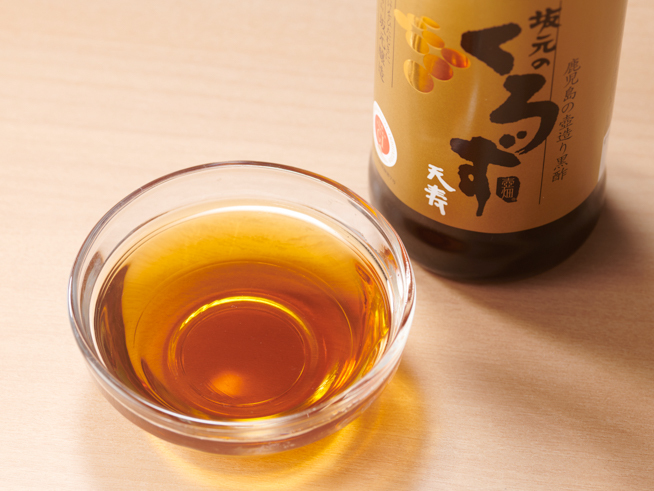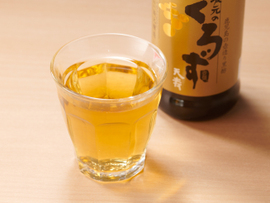
Tsubozukuri Kurozu

Fermented foods
KagoshimaTsubozukuri Kurozu
Classification (Large)
Agricultural products
Classification (Small)
Soy sauce, miso, other seasonings
Main ingredients used
rice, rice malt, water
When using downloaded images, please read the "Terms of Use" and clearly state that the source of the image is "Traditional Foods in Japan" by the Ministry of Agriculture, Forestry and Fisheries.
If the photo credits is stated, please include it as well.
Example of description
of the photo credits
Example of description when the photo credits is not stated
Source: "Traditional Foods in Japan" Ministry of Agriculture, Forestry and Fisheries
Example of description when the photo credits is stated
Source: "Traditional Foods in Japan" Ministry of Agriculture, Forestry and Fisheries
Photo credits:xxx
Region of inheritance
Fukuyama Town and Hayato Town in Kirishima City
Product overview (special characteristics and types)
Tsubozukuri black vinegar is a naturally fermented vinegar created by placing rice, malted rice, and water in a jar outdoors.
This vinegar is brewed twice a year in spring and fall, to be fermented and aged for over a year to complete the product. The method in which it is brewed and fermented in jars left outdoors is unique to this vinegar. These traditional manufacturing methods, which make the most of Kagoshima Prefecture’s mild climate and minimal temperature differences, have been handed down over time.
History and culture
Tsubozukuri black vinegar started out in Fukuyama Town, Kirishima City, Kagoshima Prefecture. It is said that the history of this vinegar goes back to the Edo period. It is called [black vinegar] as the color gradually darkens from an amber color as fermentation progresses.
Fukuyama Town is surrounded on three sides by mountains, with the town’s fourth side facing the ocean. Its location and flat terrain create a warm climate all year round, with only a small temperature difference between its highs and lows for each month, making it a perfect environment for microbial growth. Furthermore, jars of Satsuma pottery used for brewing were easily obtainable, and this is said to have led to vinegar-making in this area.
After the Second World War, the ingredient rice became scarce, so sweet potatoes were used instead, and this technique has been handed down over the generations.
In addition to amino acids, this vinegar contains nutrients such as vitamins, minerals, and organic acids, and with the recent rise in health awareness, interest in black vinegar has been growing.
Production method
Of the ingredients to make black vinegar, malted rice is created over three to four days by steaming rice with a high milling ratio and cooling before Aspergillus oryzae is used as a fermentation starter.
Steamed rice, malted rice, and water are placed in order in pottery jars that are put outside before sprinkling furikoji rice malt on the surface. Furikoji is a finished rice malt that is dried to produce spores. The mouths of the jars are covered with paper and a lid to shield from rain to let the vinegar ferment and mature. This manufacturing method in which saccharification, alcohol fermentation, and acetic acid fermentation proceed naturally in one container is a rare process even when seen from a global perspective.
Conservation and succession efforts
Kagoshima Prefecture established manufacturing methods and ingredient standards for foods using traditional manufacturing methods, foods that make the most of the unique qualities of the prefecture’s ingredients, and distinctive foods manufactured through unique technologies. Foods that fit these criteria are certified as [Furusato Certified Foods], and as of the end of March 2023, there are 58 foods certified under tsubozukuri rice black vinegar.
Furthermore, the tsubozukuri black vinegar of Kagoshima has been certified as a [Local Dish from the Edo Period—Traditional 100-Year Food Category] for the 100-Year Foods established by the Agency for Cultural Affairs.
In the Geographical Indication (GI) protection system of the Ministry of Agriculture, Forestry and Fisheries, this vinegar was registered in December 2015 as [Kagoshima no Tsubozukuri Kurozu].
Main consumption method
This vinegar is used as seasoning when cooking, and 20 to 30 ml is diluted four to five times to drink.
At-home recipes:Hot honey drink with tsubozukuri black vinegar

Ingredients
Tsubozukuri black vinegar
30 ml
Honey
2 tablespoons
Hot water
300 ml
How to make
Put black vinegar and honey in a cup, pour hot water, and stir well.


